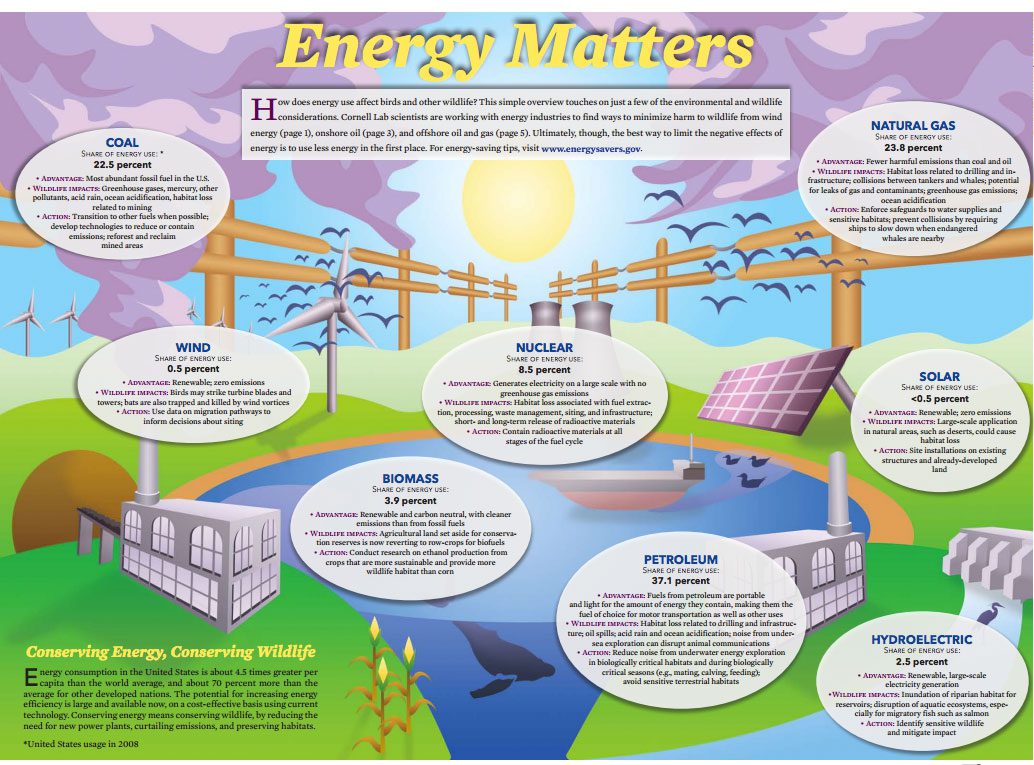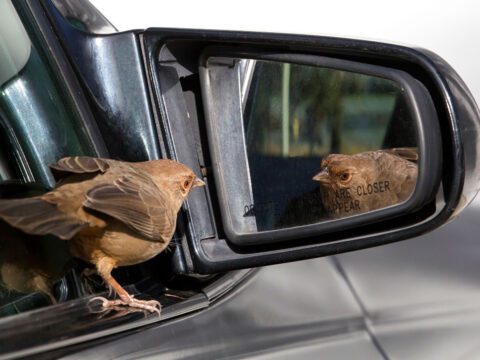Energy Matters: Conserving Energy and Wildlife
October 15, 2009How does energy use affect birds and other wildlife? This simple overview touches on just a few of the environmental and wildlife considerations. Cornell Lab scientists are working with energy industries to find ways to minimize harm to wildlife from wind energy (An Answer Is Blowin’ in the Wind), onshore oil (Hidden Costs of Energy), and offshore oil and gas (Acoustic Smog and Whales). Ultimately, though, the best way to limit the negative effects of energy is to use less energy in the first place.
Energy consumption in the United States is about 4.5 times greater per capita than the world average, and about 70 percent more than the average for other developed nations. The potential for increasing energy efficiency is large and available now, on a cost-effective basis using current technology. Conserving energy means conserving wildlife, by reducing the need for new power plants, curtailing emissions, and preserving habitats.
*all usage figures below are for the United States in 2008
Petroleum
- Share of energy use: 37.1 percent
- Advantage: Fuels from petroleum are portable and light for the amount of energy they contain, making them the fuel of choice for motor transportation as well as other uses
- Wildlife impacts: Habitat loss related to drilling and infrastructure; oil spills; acid rain and ocean acidification, noise from undersea exploration can disrupt animal communications
- Action: Reduce noise from underwater energy exploration in biologically critical habitats and during biologically critical seasons (e.g., mating, calving, feeding); avoid sensitive terrestrial habitats
Coal
- Share of energy use: 22.5 percent
- Advantage: Most abundant fossil fuel in the U.S.
- Wildlife impacts: Greenhouse gases, mercury, other pollutants, acid rain, ocean acidification, habitat loss related to mining
- Action: Transition to other fuels when possible; develop technologies to reduce or contain emissions; reforest and reclaim mined areas
Hydroelectric
- Share of energy use: 2.5 percent
- Advantage: Renewable, large-scale electricity generation
- Wildlife impacts: Inundation of riparian habitat for reservoirs; disruption of aquatic ecosystems, especially for migratory fish such as salmon.
- Action: Identify sensitive wildlife and mitigate impact
Wind
- Share of energy use: 0.5 percent
- Advantage: Renewable; zero emissions
- Wildlife impacts: Birds may strike turbine blades and towers; bats are also trapped and killed by wind vortices
- Action: Use data on migration pathways to inform decisions about siting
Natural Gas
- Share of energy use: 23.8 percent
- Advantage: Fewer harmful emissions than coal and oil
- Wildlife impacts: Habitat loss related to drilling and infrastructure; collisions between tankers and whales; potential for leaks of gas and contaminants; greenhouse gas emissions; ocean acidification
- Action: Enforce safeguards to water supplies and sensitive habitats; prevent collisions by requiring ships to slow down when endangered whales are nearby
Nuclear
- Share of energy use: 8.5 percent
- Advantage: Generates electricity on a large scale with no greenhouse gas emissions
- Wildlife impacts: Habitat loss associated with fuel extraction, processing, waste management, siting, and infrastructure; short- and long-term release of radioactive materials
- Action: Contain radioactive materials at all stages of the fuel cycle
Biomass
- Share of energy use: 3.9 percent
- Advantage: Renewable and carbon neutral, with cleaner emissions than from fossil fuels
- Wildlife impacts: Agricultural land set aside for conservation reserves is now reverting to row-crops for biofuels
- Action: Conduct research on ethanol production from crops that are more sustainable and provide more wildlife habitat than corn
Solar
- Share of energy use: <0.5 percent
- Advantage: Renewable; zero emissions
- Wildlife impacts: Large-scale application in natural areas, such as deserts, could cause habitat loss
- Action: Site installations on existing structures and already-developed land
Originally published in the Autumn 2009 issue of BirdScope.


All About Birds is a free resource
Available for everyone,
funded by donors like you







